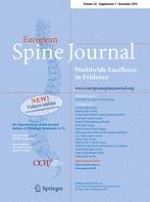01-11-2015 | Original Article
Intraoperative monitoring of somatosensory (SSEPs) and transcranial electric motor-evoked potentials (tce-MEPs) during surgical correction of neuromuscular scoliosis in patients with central or peripheral nervous system diseases
Published in: European Spine Journal | Special Issue 7/2015
Login to get accessAbstract
Purpose
Combined intraoperative monitoring (IOM) of transcranial electric motor-evoked potentials (tce-MEPs) and somatosensory-evoked potentials (SSEPs) is safe and effective for spinal cord monitoring during scoliosis surgery. However, the literature data regarding the reliability of spinal cord monitoring in patients with neuromuscular scoliosis are conflicting and need to be confirmed.
Methods
We reviewed IOM records of 40 consecutive patients with neuromuscular scoliosis related to central nervous system (CNS) (29 pts) or peripheral nervous system (PNS) (11 patients) diseases, who underwent posterior fusion with instrumentation surgery for spinal deformity. Multimodalitary IOM with SSEPs and tce-MEPs was performed.
Results
Spinal cord monitoring using at least one modality was attempted in 38/40 (95 %) patients. No false-negative results were present in either group, but a relatively high incidence of false-positive cases (4/29, 13.8 %) was noted in the CNS group. Two patients in the CNS group and one patient in the PNS group presented transient postoperative motor deficits (true positive), related to surgical manoeuvres in two cases and to malposition in the other one.
Conclusions
Multimodalitary IOM is safe and effective to detect impending spinal cord and peripheral nerves dysfunction in neuromuscular scoliosis surgery. However, the interpretation of neurophysiological data may be challenging in such patients, and the rate of false-positive results is high when pre-operatory motor deficits are severe.





